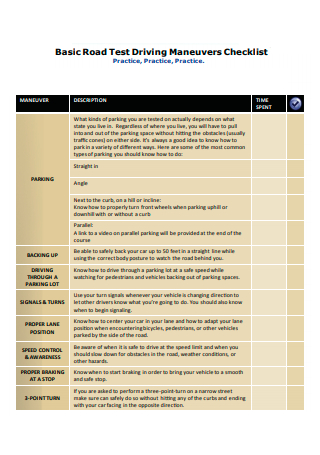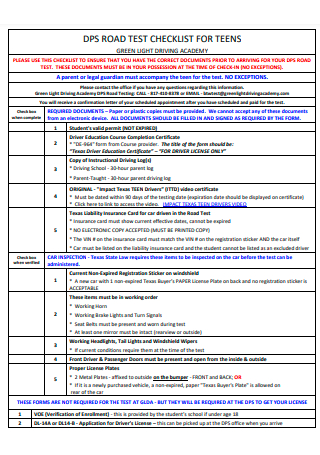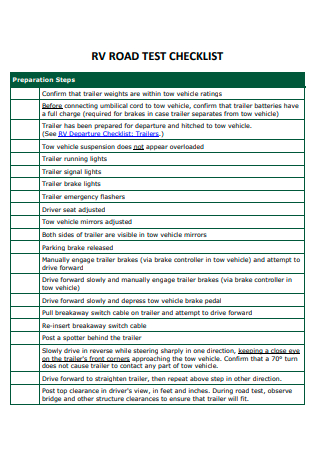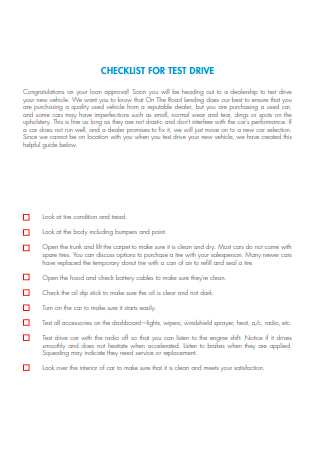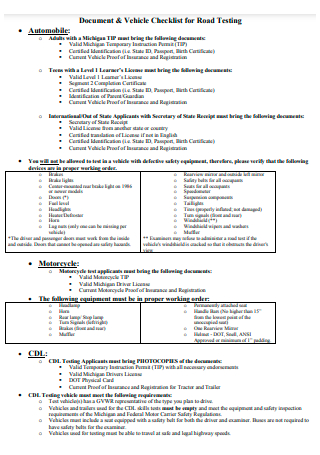4+ Sample Road Test Checklist
FREE Road Test Checklist s to Download
4+ Sample Road Test Checklist
What IS a Road Test Checklist?
Why do people fail their driving test?
Making the Road Test Checklist
FAQs
What is the SMOG technique?
What are some of the other tips you need to always remember when driving?
What are some of the skills tested on a driving test?
What IS a Road Test Checklist?
It can be unnerving sitting behind a wheel with someone from the DMV (Department of Motor Vehicles) right beside, checking if your foot is on the right pedal, your hand is at the right place, or if you’re looking at the right mirror or side, wherever you should be looking at. Hey, almost everyone gets so worked up on the day of their driver’s test, that sometimes they even forget that they know how to drive! Bit of an exaggeration, but it does happen. A road test checklist might do the trick and help you develop that confidence behind the wheel that you need. A road test has two definitions. It can mean testing a newly manufactured car under practical conditions to test its performance, or a road test can also mean testing the driving ability of an individual as part of the requirements for getting a driver’s license.
In this article, we will be focusing more on the latter, the road test checklist as a requirement for getting a driver’s license. The road test checklist is a list of reminders of the dos (sometimes even don’ts) during the practical driving exam. It could either consist of what to do or things to be done during the exam, or it could also be a checklist of things you need to prepare and bring before the exam. The road test checklist varies from state to state or from country to country. Nevertheless, the checklist is usually prepared and given by the DMV to help the driver license-applicant properly prepare for that day when they take the wheel with someone observing and scoring them from behind or right next to them.
Why do people fail their driving test?
Road tests, or driving tests, can be a very nerve-racking ordeal. Nerves getting in the way sometimes can even be the reason why people fail their driving test! It takes a lot to pass a driving test, especially when there is someone from the DMV looking at every move you made. For every turn you made, there is a corresponding score to how you made the turn. For every speed you choose to take, the same thing, there is a corresponding score to how fast or slow you choose to go. Aside from that, you have a lot of other considerations, such as the mirrors, seatbelts, gears, making a signal, and so on. Almost 40% of the people do not pass on their first shot at the road test. So, it is quite understandable when people wished you “good luck” on your road test, they literally meant it! But it’s not luck that you need to pass. But why do people fail their driving test? Here are some of the top reasons.
Making the Road Test Checklist
A checklist’s main purpose is to ensure that the user does not miss out on anything important to the task at hand. Often termed as a job aid, it helps support memory and retention by being the actual, physical piece of document that the user can refer to at any given time. There are DMVs in some states that provide a road test checklist for their driver-license applicants. Checklists would vary in format, depending on their use of it. It often comes in a yes or no format, or sometimes just as simple as a complete tickbox to be checked once the task is done. It can be elaborative as it can be, with lots of sub-section, or as simple as a grocery-looking kind of a list. But if you want to know how to make one for yourself, read on for the following essentials of a road test checklist.
-
1. Title and Identifying Details of the Checklist
To begin creating a checklist, first identify the appropriate title for your checklist. It can be as simple as a “Road Test Checklist”, or as elaborate as a “Road Test Checklist for First-Time Drivers.” This will help identify the type of checklist that you are trying to make. Next, name the owner of the checklist, or in some cases, the participant who is the subject of the checklist. Don’t forget to jot down the date, the time, and the address on where the road test will be taking place.
-
2. Start Adding Tasks
This next portion is where to start listing down your tasks. It can be in a to-do list format with yes or no tick boxes in the succeeding columns to signify task completion, or it can be an itemized sentence format with a box at the end that says complete. Other types of checklists even include another column for observations, recommendations, or feedback section. Some of the items usually found in a road test checklist include the following: windshield (must be unobstructed for both the driver and the examiner); rear-view mirrors (There should be at least two rear-view mirrors. One must be located at the inside center, and the other is on the right or left side of the car. Mirrors should be clear, unbroke, and securely fastened.); Driver window (should always be kept open throughout the test); Turn signals (left and right turn signals should be operational); tires; brake lights (should be operational); functional horn; functional emergency parking brake; knowledge of arm signals; properly working and secure safety seat belts for both the driver and the examiner; working headlights, and so on. These items cover some of the driving features for the road test. Another checklist could be made for the requirements needed to bring on the day of the road test. These items could be an original copy of your Pre-licensing Course Certificate or Student Certificate of Completion; learner permit; if under 18, a Certificate of Supervised Driving from the parent or a guardian; and/or a registered and properly inspected vehicle for the driving test that is in good and clean condition.
-
3. Tick boxes
The tick boxes could vary according to how you want to show your tasks as completed. The tick boxes are the columns, aligned right after the tasks. The tick boxes could say yes or no, or could just simply say completed.
-
4. Miscellaneous Column
Another column you could create right after the tick boxes is the comments, recommendations, or feedback column. This is where you put any observations or additional comments you have for each task. It could be that when you check the “no” tick box, you write down in that column the reason why you’re not able to complete the task. Or you could just write down any additional reminders you have for yourself for those particular tasks.
FAQs
What is the SMOG technique?
The SMOG technique was designed and developed to help drivers with their driving skills, or with changing lanes in particular. SMOG stands for Signal, Mirror, Over-the-shoulder, and Go. These are the very basic skills and highly important need-to-know when driving. Signal sends your intention to the other drivers, especially the ones from behind you, that you are about to make a move. Whether it’s for turning or for changing lanes, you must always make a signal first before doing the actual move. Mirror, or checking mirrors before making any moves will enable you to know if there are any cars behind or right beside you that will be affected by your moves. Over-the-shoulder meant looking over your shoulder for blind spots. Then Go, make the move once everything is clear.
What are some of the other tips you need to always remember when driving?
Always do SMOG. When steering, hands should be in a 9-3 position, palms down, and know how to do hand-over-hand turns. If possible, always stay in your lane. Be mindful of speed limits. Always have enough room or keep a safe distance or space between other vehicles.
What are some of the skills tested on a driving test?
Some of the skills tested on a driving test include checking if pre-drive requirements are met, such as checking functionality and performance of brakes, emergency brakes, mirrors, windshield wipers, headlights, flashers, turn signals, horns, and so on; driving through intersections; parking lot driving; lane changing; entering or backing from a curb; turning; and/or arm signals.
For first-time drivers and first-time driver’s license applicants, the day of the road test is probably one of the most nerve-racking days to look forward to. Almost as if you’re going to the dentist. Or doing your thesis finals. Well, let’s just say a very unnerving experience. Jittering nerves could get in the way while you’re doing your test, and probably is the reason why you cannot drive as confidently as you’re supposed to during the testing day. To boost your confidence, you need to be prepared and to know what you’re doing. That’s why it’s always good to have a Road Test Checklist on hand to help you out.
Need help in creating one? Download our Road Test Checklist, and start working your way through being confident on the day of your driving exam!

